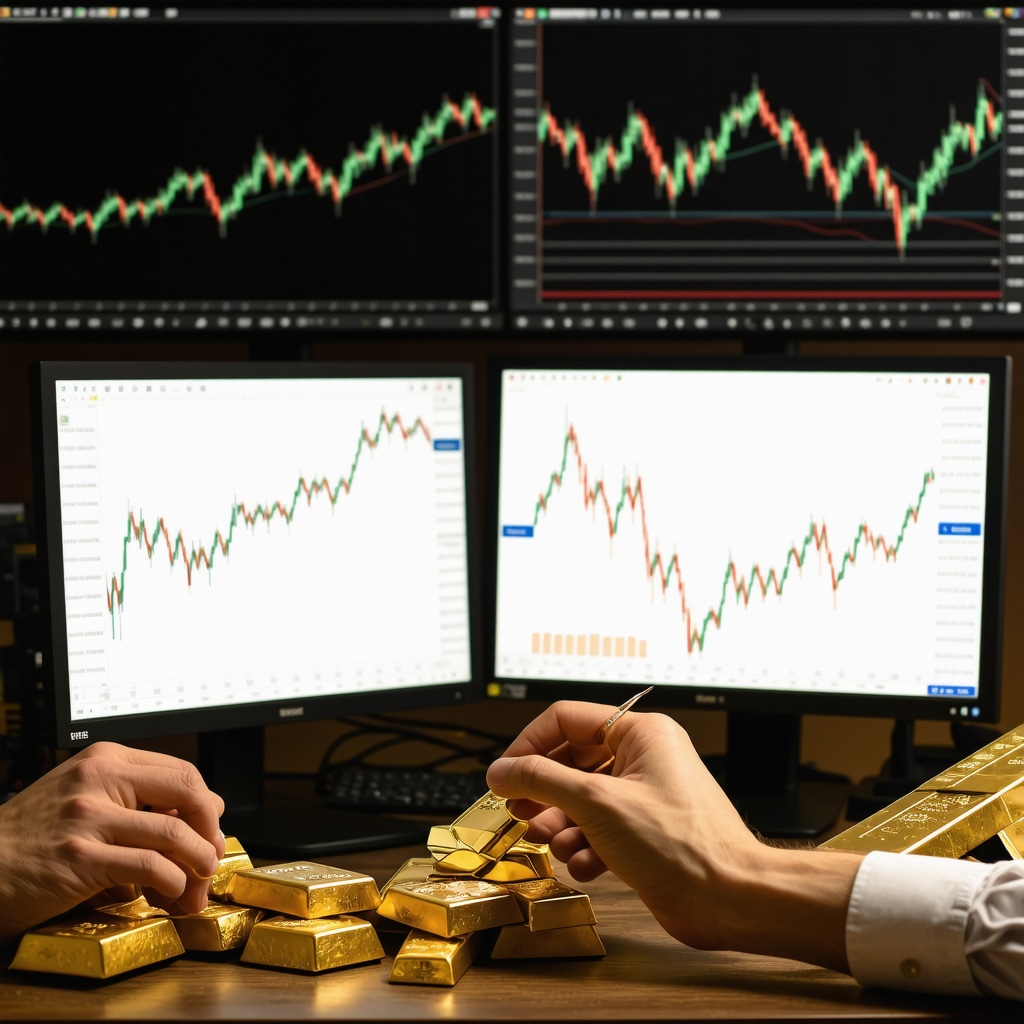Unlocking the Golden Gateway: Why Start Trading Gold Today?
Gold trading is more than just buying and selling a precious metal; it’s a strategic dance with global economic shifts, offering a unique hedge against inflation and market volatility. For beginners, stepping into the gold market can seem daunting, but armed with the right tools and strategies, it transforms into a rewarding venture that blends tradition with modern financial savvy.
Essential Tools Every Novice Gold Trader Should Have in Their Arsenal
Success in gold trading starts with having access to reliable, real-time data and trading platforms tailored for precious metals. Tools such as live gold price charts, historical trend analyzers, and volatility indicators are invaluable. For instance, platforms offering detailed analysis on supply-demand dynamics help traders anticipate price movements influenced by factors like central bank purchases or geopolitical tensions.
Moreover, understanding different gold investment vehicles—ranging from physical gold bars and coins to gold ETFs and futures contracts—is crucial. Beginners should familiarize themselves with these options to tailor their trading approach suitably. For example, physical gold offers tangible security, while ETFs provide liquidity and ease of trading.
What Are the Proven Strategies to Navigate Gold’s Volatile Market?
Gold’s price can swing dramatically due to economic indicators, currency fluctuations, and investor sentiment. Novices should adopt a disciplined approach: leveraging technical analysis to identify entry and exit points, diversifying holdings to mitigate risks, and keeping abreast of global economic news that impacts gold demand. For example, tracking central bank gold purchases can provide early signals of market shifts, as thoroughly discussed in this in-depth analysis.
Building Confidence: Practical Tips for New Gold Traders
Start small and prioritize education. Engaging with simulated trading platforms or paper trading can build experience without financial risk. Additionally, connecting with reputable gold dealers and platforms ensures secure transactions and authentic assets. Resources like guides on finding trusted dealers are invaluable for beginners.
Keep an eye on macroeconomic trends and understand how supply and demand influence gold prices. For instance, analyzing global demand trends helps predict price surges or dips, providing a strategic edge. This nuanced understanding fosters smarter investment decisions rather than speculative guesses.
Engage and Expand Your Gold Trading Journey
Have you tried any gold trading strategies as a beginner? Share your experiences or questions in the comments below to join a community dedicated to mastering gold trading. For a deeper dive into creating a balanced portfolio with gold ETFs and stocks, explore our detailed guide here.
Gold trading is a journey that demands patience, knowledge, and the right tools, but with expert guidance and continuous learning, beginners can confidently unlock the wealth-building potential of this timeless asset.
Authoritative Reference: For comprehensive insights into gold’s role in global markets, the World Gold Council provides authoritative data and analysis, accessible at gold.org.
Embracing the Emotional Ride: How I Learned to Manage Gold Trading Volatility
When I first started trading gold, I quickly realized that beyond charts and numbers, there’s an emotional rollercoaster that every trader faces. I remember watching gold prices plunge unexpectedly due to a sudden geopolitical event. My heart raced, but I reminded myself to trust the research and strategies I had developed. This experience taught me the invaluable lesson of patience and sticking to my plan, even when market noise tempts me to act impulsively.
One helpful technique I use is setting predefined stop-loss and take-profit orders. These tools not only protect my investment but also take the emotional bias out of decision-making. Over time, this discipline has made my trading experience less stressful and more consistent.
Expanding Horizons: Combining Physical Gold and Digital Investments
While I cherish the tangible security of physical gold coins and bars, I’ve also embraced digital avenues like gold ETFs and mutual funds. This diversification has helped me balance liquidity needs with long-term wealth preservation. For those curious about blending these approaches, our guide on creating a balanced portfolio is a fantastic resource.
Interestingly, recent data from the World Gold Council highlights that investor interest in gold ETFs has surged amid economic uncertainty, underscoring the appeal of digital gold as a flexible investment vehicle (source).
Have You Ever Wondered How Global Events Shape Gold Demand and Prices?
This question sparked many of my research sessions. For instance, central bank gold purchases significantly influence market dynamics. When countries increase their gold reserves, it signals confidence and can drive global prices up. Conversely, economic downturns can boost demand as investors seek safe havens.
If you want to explore how these forces interplay, check out this detailed analysis on central bank gold purchases and their impact worldwide.
Practical Advice: Safeguarding Your Gold Investments
One practical challenge I faced was securing my physical gold. I started by investing in a high-quality safe at home but later decided to use professional vault storage services for added peace of mind. If you’re new to physical gold investments, learning about secure storage methods is crucial to protect your assets from theft or damage.
Moreover, always purchasing from trusted dealers is essential. I rely on well-reviewed sources and verified dealers, like those featured in our comprehensive list of trusted gold dealers, to avoid scams and ensure authenticity.
Joining the Conversation: Share Your Gold Trading Journey
Gold trading is a deeply personal journey filled with learning curves and triumphs. I’d love to hear about your experiences, challenges, or questions. What strategies have worked for you? How do you balance physical and digital gold investments? Share your story in the comments below and let’s grow together in this fascinating market.
Decoding Market Sentiment: The Hidden Driver Behind Gold Price Movements
While fundamentals like supply-demand and geopolitical events influence gold prices, mastering market sentiment offers traders an advanced edge. Sentiment analysis involves gauging collective investor emotions through tools such as the Commitment of Traders (COT) reports, social media sentiment, and news flow. These indicators help predict short-term price reversals or sustained trends that pure technicals or fundamentals might miss.
For example, the COT report, published weekly by the Commodity Futures Trading Commission (CFTC), reveals the positions of large speculators versus commercial hedgers in gold futures. A net long position by speculators often precedes bullish price action, whereas increased hedging by commercials can signal an impending price correction. Understanding these nuanced shifts empowers traders to anticipate momentum changes before they materialize on price charts.
How Can Traders Effectively Integrate Sentiment Data Into Gold Trading Strategies?
Incorporating sentiment data requires a hybrid approach. Start by monitoring the COT report to identify extremes in positioning. Combine this with real-time sentiment analysis from financial news aggregators or specialized sentiment indices to confirm market mood. Overlaying this with technical indicators like the Relative Strength Index (RSI) or Moving Average Convergence Divergence (MACD) can validate entry and exit points.
For instance, if sentiment indicators show excessive bullishness accompanied by an RSI above 70, it might signal that gold is overbought and due for a correction. Conversely, bearish sentiment coupled with oversold technical indicators could present a buying opportunity. This multi-dimensional approach reduces false signals and enhances decision-making precision.
Leveraging Algorithmic Trading: Embracing Automation in Gold Markets
Algorithmic trading strategies have revolutionized how traders approach gold markets by automating complex analyses and executing trades at speeds impossible for humans. These algorithms can process vast datasets, including price movements, sentiment metrics, and macroeconomic indicators, to identify optimal trade setups.
Quantitative models, such as mean reversion and momentum strategies, are popular in gold trading algorithms. Mean reversion exploits the tendency of gold prices to revert to an average after extreme moves, while momentum strategies capitalize on sustained trends. By programming these strategies into trading bots, traders can reduce emotional biases and systematically capture market opportunities.
However, algorithmic trading requires rigorous backtesting and ongoing refinement to adapt to evolving market conditions. Traders should also be mindful of execution risks such as slippage and latency, ensuring their platforms offer reliable infrastructure.
Advanced Risk Management: Beyond Stop-Losses and Diversification
In the volatile realm of gold trading, sophisticated risk management extends beyond conventional stop-loss orders. Techniques such as position sizing based on volatility, correlation analysis with other assets, and scenario stress testing provide deeper risk insights.
For example, using the Average True Range (ATR) to adjust position sizes allows traders to scale their exposure dynamically according to market volatility, preserving capital during turbulent periods. Additionally, analyzing correlations between gold and other commodities or currencies helps in constructing portfolios that truly diversify risk rather than inadvertently increasing it.
Stress testing hypothetical scenarios, such as sudden geopolitical crises or rapid interest rate changes, prepares traders for extreme outcomes, enabling preemptive strategy adjustments. These layered risk controls are essential for sustaining long-term profitability in gold markets.
Authoritative Reference: For an in-depth exploration of sentiment analysis and algorithmic trading in commodities, refer to the CFTC Commitment of Traders Reports and academic publications such as “Algorithmic Trading and DMA: An Introduction to Direct Access Trading Strategies” by Barry Johnson.
Ready to elevate your gold trading game with cutting-edge techniques? Dive deeper into integrating sentiment and technical analysis by subscribing to our expert newsletter, where we unpack complex strategies with actionable insights tailored for ambitious traders.
Decoding Market Sentiment: The Hidden Driver Behind Gold Price Movements
While fundamentals like supply-demand and geopolitical events influence gold prices, mastering market sentiment offers traders an advanced edge. Sentiment analysis involves gauging collective investor emotions through tools such as the Commitment of Traders (COT) reports, social media sentiment, and news flow. These indicators help predict short-term price reversals or sustained trends that pure technicals or fundamentals might miss.
For example, the COT report, published weekly by the Commodity Futures Trading Commission (CFTC), reveals the positions of large speculators versus commercial hedgers in gold futures. A net long position by speculators often precedes bullish price action, whereas increased hedging by commercials can signal an impending price correction. Understanding these nuanced shifts empowers traders to anticipate momentum changes before they materialize on price charts.
How Can Traders Effectively Integrate Sentiment Data Into Gold Trading Strategies?
Incorporating sentiment data requires a hybrid approach. Start by monitoring the COT report to identify extremes in positioning. Combine this with real-time sentiment analysis from financial news aggregators or specialized sentiment indices to confirm market mood. Overlaying this with technical indicators like the Relative Strength Index (RSI) or Moving Average Convergence Divergence (MACD) can validate entry and exit points.
For instance, if sentiment indicators show excessive bullishness accompanied by an RSI above 70, it might signal that gold is overbought and due for a correction. Conversely, bearish sentiment coupled with oversold technical indicators could present a buying opportunity. This multi-dimensional approach reduces false signals and enhances decision-making precision.
Leveraging Algorithmic Trading: Embracing Automation in Gold Markets
Algorithmic trading strategies have revolutionized how traders approach gold markets by automating complex analyses and executing trades at speeds impossible for humans. These algorithms can process vast datasets, including price movements, sentiment metrics, and macroeconomic indicators, to identify optimal trade setups.
Quantitative models, such as mean reversion and momentum strategies, are popular in gold trading algorithms. Mean reversion exploits the tendency of gold prices to revert to an average after extreme moves, while momentum strategies capitalize on sustained trends. By programming these strategies into trading bots, traders can reduce emotional biases and systematically capture market opportunities.
However, algorithmic trading requires rigorous backtesting and ongoing refinement to adapt to evolving market conditions. Traders should also be mindful of execution risks such as slippage and latency, ensuring their platforms offer reliable infrastructure.
Advanced Risk Management: Beyond Stop-Losses and Diversification
In the volatile realm of gold trading, sophisticated risk management extends beyond conventional stop-loss orders. Techniques such as position sizing based on volatility, correlation analysis with other assets, and scenario stress testing provide deeper risk insights.
For example, using the Average True Range (ATR) to adjust position sizes allows traders to scale their exposure dynamically according to market volatility, preserving capital during turbulent periods. Additionally, analyzing correlations between gold and other commodities or currencies helps in constructing portfolios that truly diversify risk rather than inadvertently increasing it.
Stress testing hypothetical scenarios, such as sudden geopolitical crises or rapid interest rate changes, prepares traders for extreme outcomes, enabling preemptive strategy adjustments. These layered risk controls are essential for sustaining long-term profitability in gold markets.
Authoritative Reference: For an in-depth exploration of sentiment analysis and algorithmic trading in commodities, refer to the CFTC Commitment of Traders Reports and academic publications such as “Algorithmic Trading and DMA: An Introduction to Direct Access Trading Strategies” by Barry Johnson.
Ready to elevate your gold trading game with cutting-edge techniques? Subscribe to our expert newsletter for exclusive insights, advanced strategies, and actionable tips that empower ambitious traders to master the complexities of the gold market.
Frequently Asked Questions (FAQ)
What is the best way for beginners to start trading gold?
Beginners should start by educating themselves about gold markets, including the various investment vehicles such as physical gold, ETFs, futures, and CFDs. Utilizing simulated trading platforms to practice without financial risk, focusing on reliable data sources, and starting with small, manageable investments help build confidence. Establishing a disciplined trading plan with risk management strategies is essential to navigating gold’s volatility effectively.
How do global events influence gold prices?
Gold prices are highly sensitive to global events such as geopolitical tensions, economic crises, changes in central bank policies, and currency fluctuations. For instance, increased central bank gold purchases often signal confidence and push prices up, while economic downturns drive investors towards gold as a safe haven. Understanding these macroeconomic drivers allows traders to anticipate price movements and adjust strategies accordingly.
What are the advantages and disadvantages of trading physical gold versus gold ETFs?
Physical gold offers tangible ownership, long-term security, and protection against currency risks but requires secure storage and liquidity can be lower. Gold ETFs provide ease of trading, diversification, and liquidity but come with management fees and counterparty risks. Combining both can balance liquidity needs with asset security in a diversified portfolio.
How can sentiment analysis improve gold trading decisions?
Sentiment analysis gauges investor emotions through tools like the Commitment of Traders (COT) reports, social media trends, and news flow. Integrating sentiment with technical indicators helps identify market extremes and potential reversals, enhancing timing and precision. For example, excessive bullish sentiment paired with overbought technical signals may warn of an impending correction.
What role does algorithmic trading play in gold markets?
Algorithmic trading automates complex analyses and trade executions using quantitative models such as mean reversion and momentum strategies. This reduces emotional bias and enables rapid response to market changes. However, it requires rigorous backtesting, infrastructure reliability, and ongoing adaptation to maintain effectiveness in dynamic gold markets.
How should traders manage risk in gold trading beyond basic stop-loss orders?
Advanced risk management includes adjusting position sizes based on volatility metrics like Average True Range (ATR), analyzing correlations with other assets to ensure true diversification, and conducting scenario stress tests for extreme market events. These layered strategies help preserve capital and maintain consistent profitability despite gold’s inherent volatility.
Is it necessary to diversify gold investments across physical and digital forms?
Yes, diversification across physical gold and digital instruments such as ETFs or mutual funds balances liquidity, convenience, and security. Physical gold provides tangible asset security, while digital investments allow easier portfolio rebalancing and access to market movements. This hybrid approach optimizes risk-adjusted returns.
What are the key technical indicators useful for gold trading?
Indicators like Relative Strength Index (RSI) identify overbought or oversold conditions, Moving Average Convergence Divergence (MACD) signals momentum shifts, and volatility measures such as Average True Range (ATR) help gauge price movement magnitude. Combining these with sentiment data enhances trade timing and decision-making.
How can new traders find reliable gold dealers to avoid scams?
Traders should research dealers with strong reputations, transparent pricing, verified customer reviews, and memberships in recognized industry associations. Resources and guides on trusted dealers, like those linked in this article, provide vetted options to ensure authenticity and safe transactions when purchasing physical gold.
What are the best practices for securely storing physical gold?
Secure storage options include high-quality home safes, bank safety deposit boxes, or professional vault storage services. Each option varies in cost, accessibility, and security level. Insuring physical gold and maintaining documentation of ownership further protect assets against theft or loss.
Trusted External Sources
- World Gold Council (gold.org): Provides comprehensive data, market analysis, and research on gold demand, supply, and investment trends globally, making it a cornerstone resource for informed gold trading decisions.
- Commodity Futures Trading Commission (CFTC) Commitment of Traders Reports (cftc.gov): Offers weekly insights into futures market positions held by different trader categories, essential for sentiment analysis and understanding market dynamics in gold futures.
- Barry Johnson’s “Algorithmic Trading and DMA: An Introduction to Direct Access Trading Strategies”: A seminal academic resource detailing algorithmic trading strategies and implementation, vital for traders interested in quantitative approaches to gold markets.
- Kitco News (kitco.com): Renowned for up-to-date precious metals news, expert commentary, and live price feeds, Kitco is valuable for tracking market sentiment and technical developments.
- London Bullion Market Association (LBMA) (lbma.org.uk): The authoritative body for the global wholesale gold market, offering market standards, statistics, and best practices essential for professional traders and investors.
Conclusion
Gold trading presents a multifaceted opportunity blending historical allure with sophisticated modern strategies. Mastery requires understanding the interplay of global economic events, market sentiment, and technical analysis, while leveraging tools like algorithmic trading and advanced risk management to navigate volatility confidently. Whether investing in physical gold or digital instruments, a balanced, informed approach safeguards capital and capitalizes on gold’s unique role as a financial hedge.
By embracing continuous education, disciplined strategies, and trusted resources, traders at all levels can unlock gold’s wealth-building potential. Engage with our expert content, share your experiences, and apply these insights to elevate your gold trading journey to new heights.










